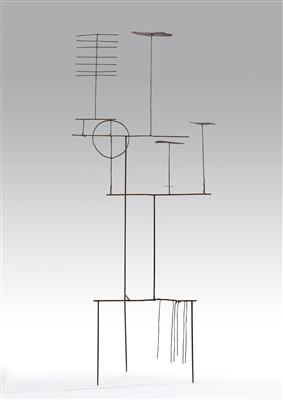Fausto Melotti *

(Rovereto 1901–1986 Milan)
Linee, 1961, brass, 116 x 40 x 17 cm, in Plexiglas box, (AR)
View this three-dimensional object in our short Video.
Photo certificate with artist’s signature, 18 October 1978
Provenance:
Umberto Allemandi Collection, Turin
Alberto M. Scalettaris, Turin
Sotheby’s Milan, 27 November 1990, lot 226
Valeria Belvedere Collection, Milan
European Private Collection
Exhibition:
Parma, Università di Parma, Sala delle Scuderie in Pilotta, Fausto Melotti, 8 June - 11 July 1976, no. 128;
Valencia, IVAM Centre Julyo Gonzales, Generalitat Valenciana, Conselleria de Cultura, Fausto Melotti, 16 December 1994 – 12 February 1995, exh. cat. p.136 and 190 with ill.
Literature:
Germano Celant, Melotti. Catalogo generale. Sculture 1929–1972, Electa (Ed.), Milan 1994, Volume I, pp. 130 and 131, no. 1961 13 with ill.
The sensations of harmony and counterpoint can be found in geometry [...] Art is an angelical and geometric mood. These are Melotti’s words in the preface to the catalogue of his first solo exhibition at the Galleria del Milione in 1935: a sort of theorem, on which his entire artistic activity would be based, influenced by his scientific knowledge and his passion for music.
Melotti was born in Rovereto in 1901 and found his language in the thriving artistic milieu of Milan in the 1930s, where the then newly born Galleria del Milione displayed works by representatives of the international avant-garde movements (Léger, Vordemberge, Kandinsky, Albers) as well as their Italian counterparts (Veronesi, Soldati, Licini, Reggiani, Radice, Fontana).
The works produced in those years, expressing a form of abstraction that was partly the result of the influence of architects such as Terragni, Sartoris and Le Corbusier, were for the most part destroyed by the bombing during the war, the horrors of which caused Melotti to distance himself from the idealised abstraction of his early years, and to remain silent for about twenty years.
When he returned to his inventions in 1959, he created works in which the initial geometric abstraction was enriched by a new narrative that was dream-like, symbolic and poetic at once.
During that period he started working on thread-like sculptures, nearly two-dimensional and yet capable of conquering space with elegant discretion and of building magical environments and theatrical spaces, which can be linked to a certain extent to the aforementioned series centred on the ‘teatrini’ (little theatres).
I use metal because it brings me close to drawing: with metal I can draw in space. (Fausto Melotti).
By soldering and slimming down his metals until they become vibrant in their litheness, Melotti realises a very personal idea of sculpture that is perfectly manifest in his 1961 work ‘Linee’ [lines].
It is made of brass, a light and malleable material, and presents itself like a fantastical apparition, a fairy-tale vision, a stage on which subtle and lithe figures – thread-like stems reminiscent of the vegetable and floral kingdom – vibrate with every movement of the air, no matter how slight, shine in the aerial quality when light breaks upon them. Despite their ‘immateriality’, those metallic figures – which are so perfectly studied and balanced – seem to become alive, freeing themselves from their merely geometrical significance made of lines, signs and circles, as if galvanised by a secret vital lymph.
Specialist: Alessandro Rizzi
 Alessandro Rizzi
Alessandro Rizzi
+39-02-303 52 41
alessandro.rizzi@dorotheum.it
10.06.2015 - 19:00
- Realized price: **
-
EUR 369,000.-
- Estimate:
-
EUR 150,000.- to EUR 200,000.-
Fausto Melotti *
(Rovereto 1901–1986 Milan)
Linee, 1961, brass, 116 x 40 x 17 cm, in Plexiglas box, (AR)
View this three-dimensional object in our short Video.
Photo certificate with artist’s signature, 18 October 1978
Provenance:
Umberto Allemandi Collection, Turin
Alberto M. Scalettaris, Turin
Sotheby’s Milan, 27 November 1990, lot 226
Valeria Belvedere Collection, Milan
European Private Collection
Exhibition:
Parma, Università di Parma, Sala delle Scuderie in Pilotta, Fausto Melotti, 8 June - 11 July 1976, no. 128;
Valencia, IVAM Centre Julyo Gonzales, Generalitat Valenciana, Conselleria de Cultura, Fausto Melotti, 16 December 1994 – 12 February 1995, exh. cat. p.136 and 190 with ill.
Literature:
Germano Celant, Melotti. Catalogo generale. Sculture 1929–1972, Electa (Ed.), Milan 1994, Volume I, pp. 130 and 131, no. 1961 13 with ill.
The sensations of harmony and counterpoint can be found in geometry [...] Art is an angelical and geometric mood. These are Melotti’s words in the preface to the catalogue of his first solo exhibition at the Galleria del Milione in 1935: a sort of theorem, on which his entire artistic activity would be based, influenced by his scientific knowledge and his passion for music.
Melotti was born in Rovereto in 1901 and found his language in the thriving artistic milieu of Milan in the 1930s, where the then newly born Galleria del Milione displayed works by representatives of the international avant-garde movements (Léger, Vordemberge, Kandinsky, Albers) as well as their Italian counterparts (Veronesi, Soldati, Licini, Reggiani, Radice, Fontana).
The works produced in those years, expressing a form of abstraction that was partly the result of the influence of architects such as Terragni, Sartoris and Le Corbusier, were for the most part destroyed by the bombing during the war, the horrors of which caused Melotti to distance himself from the idealised abstraction of his early years, and to remain silent for about twenty years.
When he returned to his inventions in 1959, he created works in which the initial geometric abstraction was enriched by a new narrative that was dream-like, symbolic and poetic at once.
During that period he started working on thread-like sculptures, nearly two-dimensional and yet capable of conquering space with elegant discretion and of building magical environments and theatrical spaces, which can be linked to a certain extent to the aforementioned series centred on the ‘teatrini’ (little theatres).
I use metal because it brings me close to drawing: with metal I can draw in space. (Fausto Melotti).
By soldering and slimming down his metals until they become vibrant in their litheness, Melotti realises a very personal idea of sculpture that is perfectly manifest in his 1961 work ‘Linee’ [lines].
It is made of brass, a light and malleable material, and presents itself like a fantastical apparition, a fairy-tale vision, a stage on which subtle and lithe figures – thread-like stems reminiscent of the vegetable and floral kingdom – vibrate with every movement of the air, no matter how slight, shine in the aerial quality when light breaks upon them. Despite their ‘immateriality’, those metallic figures – which are so perfectly studied and balanced – seem to become alive, freeing themselves from their merely geometrical significance made of lines, signs and circles, as if galvanised by a secret vital lymph.
Specialist: Alessandro Rizzi
 Alessandro Rizzi
Alessandro Rizzi
+39-02-303 52 41
alessandro.rizzi@dorotheum.it
|
Buyers hotline
Mon.-Fri.: 10.00am - 5.00pm
kundendienst@dorotheum.at +43 1 515 60 200 |
| Auction: | Contemporary Art, Part I |
| Auction type: | Saleroom auction |
| Date: | 10.06.2015 - 19:00 |
| Location: | Vienna | Palais Dorotheum |
| Exhibition: | 30.05. - 10.06.2015 |
** Purchase price incl. charges and taxes
It is not possible to turn in online buying orders anymore. The auction is in preparation or has been executed already.
